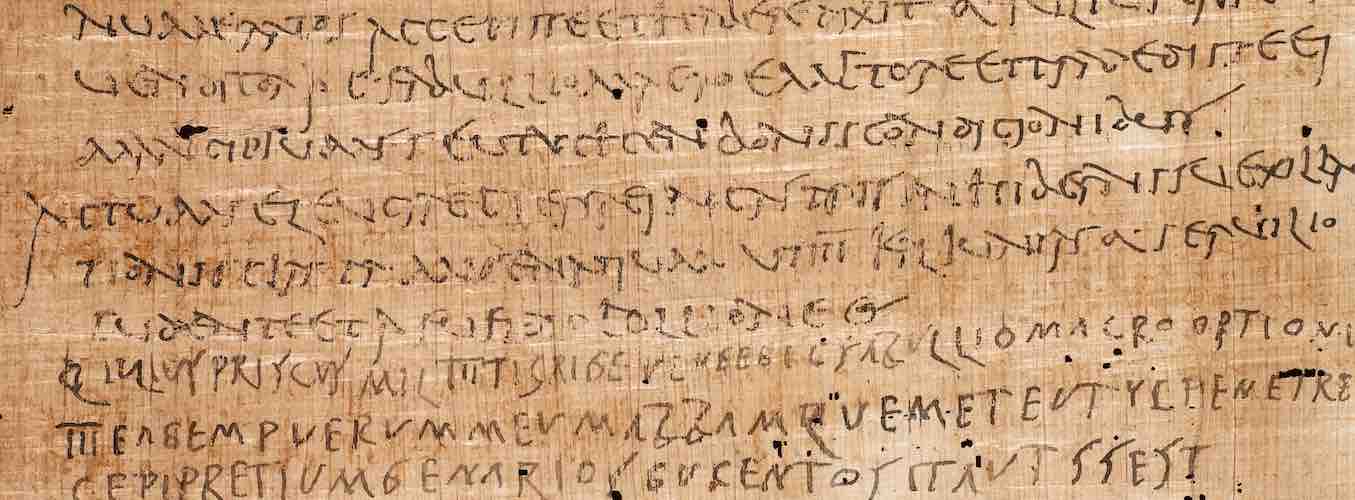Transcribe
Latin Classical Antiquity - Transcription

Description
The majuscule and minuscule scripts used in the Roman world: Square Capitals, Rustic Capitals, Older Roman Cursive, and Later Roman Cursive.
Reminders, Hints and Instructions
This first transcription exercise will give you practice transcribing a manuscript in scriptio continua — completely without word separation.
Remember the transcription principles and conventions we discussed in the Transcription Basics lesson. Here are the ones particularly applicable to this manuscript:
- DO add modern word separation, but do NOT add any other conventions for the modern presentation of text or in any other way correct the scribe's Latin.
- This manuscript uses one abbreviation: enclitic -que is written as Q with a dot after it. As we discussed in the Transcription Basics lesson, you should expand the abbreviation and put in parentheses any letters that you supply. So if the scribe writes Q followed by a dot, you will expand that: q(ue)
- When transcribing, we use capital letters only to indicate where the scribe has made a letter more prominent than the main text for emphasis. Since this manuscript is written entirely in majuscule, capital letters per se do not indicate emphasis. You should therefore transcribe the whole thing in lower case.
- Important related note: In Latin scripts from antiquity until the late Middle Ages, u and v are just variant forms of the same letter. V is used as the majuscule form in some scripts (as here), and at the beginning of words in some late medieval minuscule scripts. When you are transcribing everything into lower case, you should use u for all appearances of either the u form or the v form.
- Because this is a manuscript of Vergil's Aeneid, it is laid out in verse lines. Although the scribe does not separate words from one another, each line of writing does end with a complete word. You should not, therefore, have to worry about hyphenating words at line end.
- Since this copy is fragmentary and damaged, some letters are missing. As we practiced in the Basics lesson, you should use double square brackets [[ ]] to indicate any place where you can see that there is or was a letter that is now too damaged for you to make it out. Do not record letters or words that would have been on parts of the page that are now completely missing. That is, you do not need to use your knowledge of Vergil to presume how each line began. The important thing here is to record what you see in the manuscript.
When you are ready, try transcribing the whole page! After you've had a try, you can display the answer key.
Exercise 1
1
2
3
4
5
6
7
8
9
10
11
12
13
14
15
16
17
18
St. Gallen, Stiftsbibliothek, Cod. Sang. 1394, p. 12. (www.e‑codices.unifr.ch)
Transcription Answer
1 [[*]]enum struere et flammis adolere penates
2 [[*]]m aliae totidemq(ue) pares aetate ministri
3 ibus mensas onerant et pocula ponunt
4 on et tyrii per limina laeta frequentes
5 enere toris iussi discumbere pictis
6 antur dona aeneae mirantur iulum
7 grantisq(ue) dei uultus simulataque uerba
8 amq(ue) et pictum croceo uelamen acantho
9 ecipue infelix pesti deuota futurae
10 le[[*]]i mentem nequit ardescitque tuendo
11 e[[*]]issa et pariter puero donisq(ue) mouetur
12 ubi complexum aeneae colloq(ue) pependit
13 agnum falsi inpleuit genitoris amorem
14 inam petit haec oculis haec pectore toto
15 ret et interdum gremio fouet inscia dido
16 deat quantus miserae deus ac memor ille
17 ris acidaliae paulatim abolere sychaeum
18 [[**]]t et uiuo temptat praeuertere amore
2 [[*]]m aliae totidemq(ue) pares aetate ministri
3 ibus mensas onerant et pocula ponunt
4 on et tyrii per limina laeta frequentes
5 enere toris iussi discumbere pictis
6 antur dona aeneae mirantur iulum
7 grantisq(ue) dei uultus simulataque uerba
8 amq(ue) et pictum croceo uelamen acantho
9 ecipue infelix pesti deuota futurae
10 le[[*]]i mentem nequit ardescitque tuendo
11 e[[*]]issa et pariter puero donisq(ue) mouetur
12 ubi complexum aeneae colloq(ue) pependit
13 agnum falsi inpleuit genitoris amorem
14 inam petit haec oculis haec pectore toto
15 ret et interdum gremio fouet inscia dido
16 deat quantus miserae deus ac memor ille
17 ris acidaliae paulatim abolere sychaeum
18 [[**]]t et uiuo temptat praeuertere amore